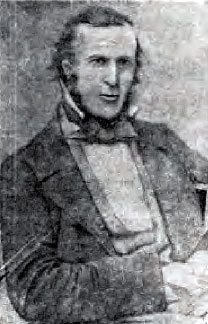Lefevre James Cranstone facts for kids
Quick facts for kids
Lefevre James Cranstone
|
|
|---|---|

Photograph of Lefevre James Cranstone, c.1859
|
|
| Born | March 6, 1822 Hemel Hempstead, UK
|
| Died | June 22, 1893 (aged 71) Brisbane, Australia
|
| Resting place | Toowong Cemetery, Brisbane |
| Alma mater |
|
| Known for | Landscape paintings and sketches |
| Movement | Genre art |
| Spouse(s) | Lillia Messenger |
Lefevre James Cranstone (born March 6, 1822 – died June 22, 1893) was an English artist. He was famous for his beautiful landscape paintings, especially those done with watercolors. He also created oil paintings. Cranstone traveled to the United States, and many of his artworks are still there today. Later in his life, he moved to Australia.
Contents
Early Life and Art Training
Lefevre James Cranstone grew up in Hemel Hempstead, England. He was one of thirteen children. When he was 16, he started studying art at Henry Sass's School of Art in London. Two years later, in 1840, he was accepted into the Royal Academy School. This was a very important art school.
After finishing his training, Cranstone showed many of his oil paintings. He exhibited them at the Royal Society of British Artists and the Royal Academy. Besides his watercolor and oil paintings, he also created etchings and drawings using pen, ink, and chalk. Cranstone was also an art teacher at a boarding school run by his wife, Lillia.
Artworks and American Journey


Even though he showed his art in famous places in Britain, Cranstone became much more well-known for his work in America. In 1859 and 1860, Cranstone and his younger brother, Alfred, visited their cousins in Virginia and Indiana. They stayed for ten months.
During this trip, Cranstone made almost 300 sketches using pen, ink, and wash. These drawings showed what life was like in American cities and the countryside before the American Civil War. Some of his works from this time include paintings of the Ohio River in Wheeling, West Virginia, the White House in Washington DC, and the Courthouse in Colonial Williamsburg.
Many of the sketches he made during his American visit were later sold. Today, some are kept at the Lilly Library at Indiana University Bloomington. In 1933, 98 larger watercolor versions of his sketches were sold. One of these was an oil painting called Slave Auction, Virginia. This painting is now at the Virginia Museum of History & Culture.
Cranstone's Views on Slavery
A book about Cranstone by Donald L. Smith includes a copy of the Slave Auction, Virginia painting. It also has a letter Cranstone wrote in 1860 to a newspaper in England. In this letter, he shared his strong feelings about the election of Abraham Lincoln as President. He spoke out against the cruelty of slavery and described in detail the terrible scene of a slave auction he witnessed in Richmond, Virginia.
Where to Find Cranstone's Art
Cranstone's paintings are displayed in many important art collections. You can find them at the White House, the Metropolitan Museum of Art, and the Museum of Fine Arts, Boston. Other places include the Virginia Historical Society, the Virginia Museum of Fine Arts, and the Colonial Williamsburg Foundation. Some of his works are also in England at the Dacorum Heritage Trust.
He also created an art collection in Australia. This collection, along with a book of illustrated poetry he brought from England, is at the John Oxley Library in Brisbane.
Later Life in Australia
In 1882, Cranstone's wife, Lillia, passed away at the age of 59. She had been running a school in Hemel Hempstead, which closed after her death.
After Lillia's death, Cranstone decided to start a new life in Australia. His oldest son, William, had just become a doctor. In October 1882, the Cranstone family sailed to Australia. This included Lefevre James Cranstone, his children Beatrice Lillia and Frederic George, and William with his new wife, Ellen Kent. They arrived in Sydney Harbour in January 1883.
From the day they arrived, Cranstone began sketching the local landscapes and seascapes. The family moved to a small town called Clermont in Queensland. There, William became the Chief Surgeon at the Peak Downs Hospital. While living in Clermont, Lefevre James drew many pen-and-ink pictures of the areas around Wolfang, Retro, and Emu Park.
In 1889, Cranstone moved with his daughter Beatrice to Brisbane. He continued to draw local scenes until he passed away. Lefevre James Cranstone died on June 22, 1893. He was buried on the same day at Toowong Cemetery in Brisbane.

